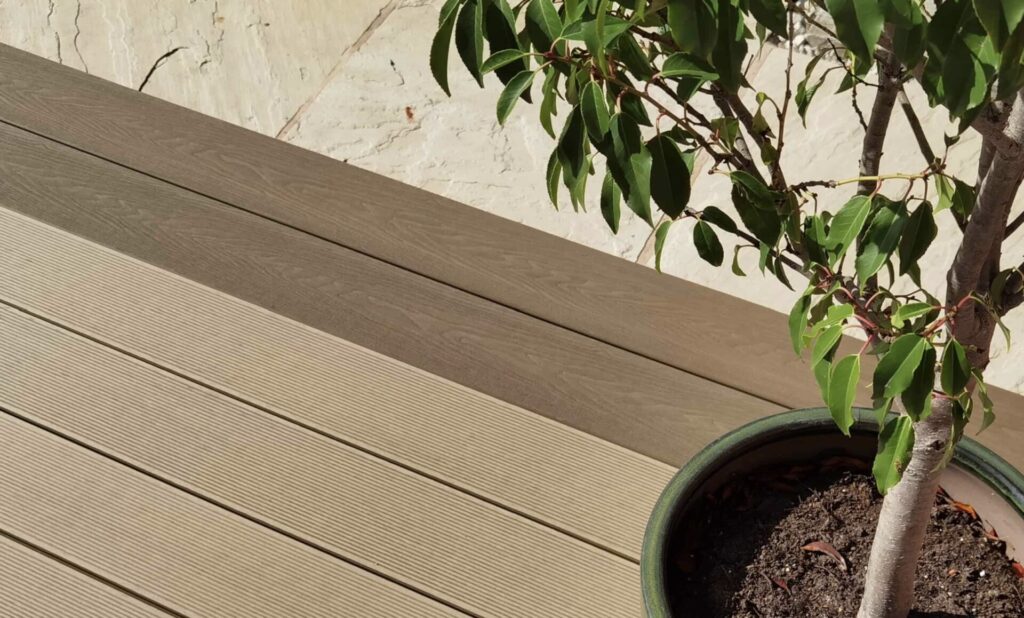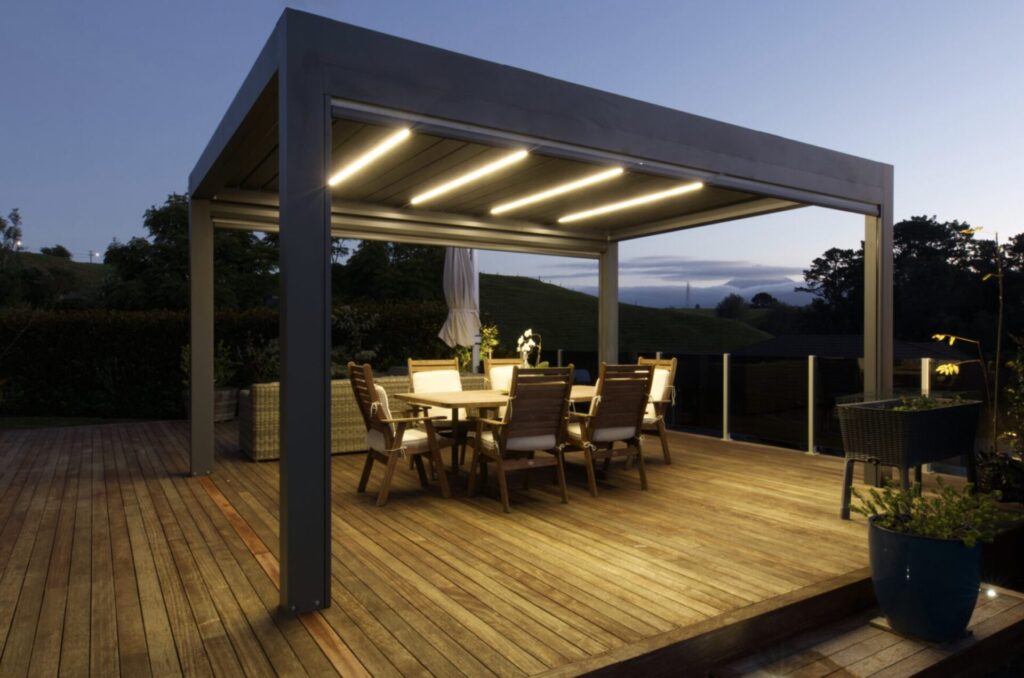Transforming your outdoor space into a seamless extension of your indoor living area is a quintessential part of New Zealand’s lifestyle. Decking plays a pivotal role in achieving this harmony, and it’s a sought-after feature that can enhance your home’s appeal and value. The decision-making process doesn’t stop at just wanting a deck; it extends to choosing the right material that suits your lifestyle and the unique climate of New Zealand.
In our comprehensive guide, we delve into the variety of decking materials on offer in New Zealand, weighing up their advantages and drawbacks, as well as their upkeep needs. Whether you’re looking for the warm traditionalism of timber or the robust, low-maintenance appeal of composite materials, our guide is crafted to inform and inspire your decking choices.
With a focus on the New Zealand market, we provide insights that are both relevant and practical, tailored to local homeowners. We aim to simplify your decision process by presenting clear, concise information, enabling you to select a decking material that not only meets your aesthetic preferences but also stands the test of time in New Zealand’s unique environmental conditions.
Join us as we navigate the nuances of each decking option, helping you to lay the foundation for your ideal outdoor sanctuary. With the right knowledge, your journey towards a beautiful, durable deck is just a step away.
Table of Contents
I. Introduction
Opting for the perfect decking material is vital for the enrichment of your outdoor living area. The material choice greatly impacts the endurance, aesthetic, and tactile quality of your decking. In the New Zealand context, homeowners frequently opt for materials like timber, composite, PVC, concrete, and popular timber varieties such as Kwila and Garapa. Each material comes with distinctive characteristics, which we will delve into further.
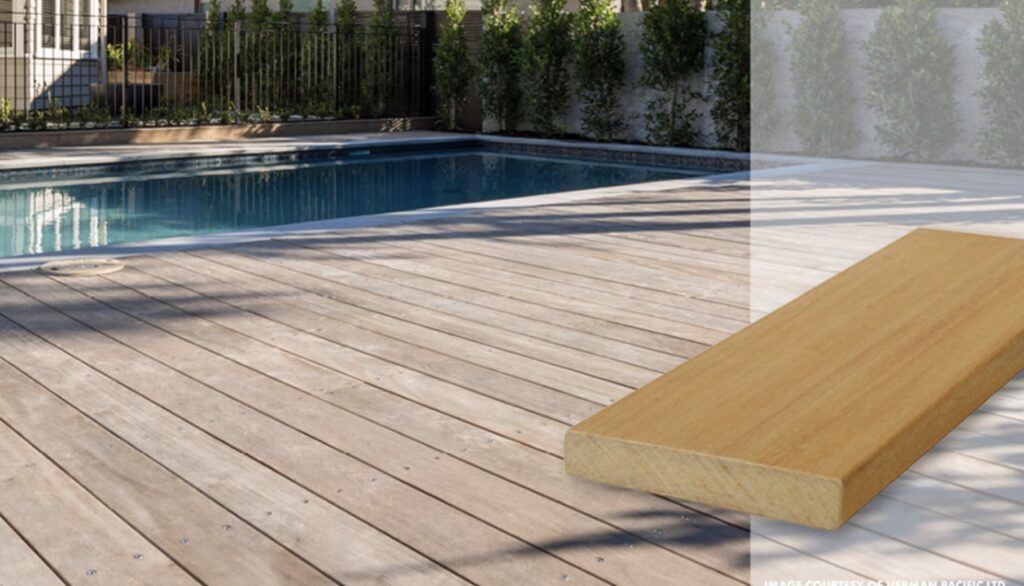
II. Timber Decking
Timber decking stands as a time-honored selection for many in New Zealand, renowned for the inherent warmth and beauty it brings to outdoor spaces. Predominantly, the choices narrow down to treated pine and a variety of hardwoods.
a. Treated Pine Decking
For those managing their expenditures, treated pine decking emerges as an economical choice. This type of softwood undergoes chemical treatment, enhancing its resistance to decay and pests. Treated pine is commonly found in H3 and H4 grades, where H3 is engineered for above-ground applications, and H4 is robust enough to withstand direct ground contact.
Benefits of Treated Pine Decking:
- Affordability: It stands as one of the more budget-friendly options compared to hardwoods and certain composites, thus appealing to cost-conscious individuals.
- User-friendly: With its ease of cutting, drilling, and fastening, treated pine is a go-to for DIY projects.
- Variety in Grades: The availability of various grades allows for flexibility in selection based on project requirements and financial plans.
- Enhanced Durability: Thanks to preservatives, treated pine withstands decay and insect damage better than non-treated woods.
Drawbacks of Treated Pine Decking:
- Susceptibility to Damage: Over time, treated pine may exhibit tendencies to split and warp, particularly if not correctly cared for.
- Maintenance Needs: To preserve its look and longevity, treated pine decking demands consistent upkeep, including cleaning, staining, and sealing.
- Comparative Durability: While more enduring than untreated timber, treated pine typically does not offer the same lifespan as hardwoods, especially in high-traffic or weather-exposed environments.
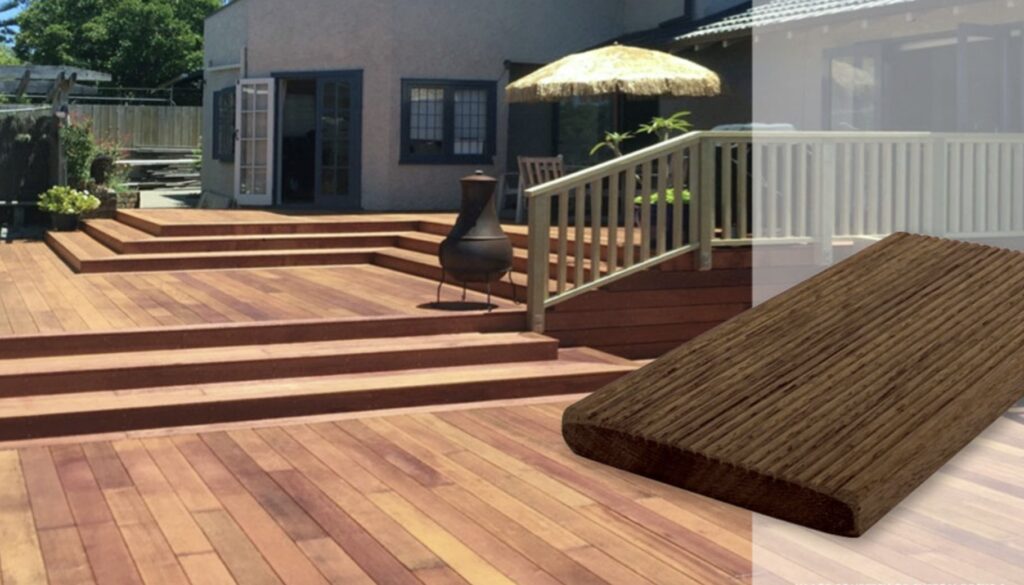
b. Hardwood Decking
Hardwood decking represents the pinnacle of outdoor decking materials, prized for its unrivaled natural allure, robustness, and longevity. In New Zealand, Kwila and Garapa are the hardwood species most often chosen for decking projects.
Kwila Hardwood Decking:
Kwila, known for its rich, reddish-brown hue, is a highly sought-after hardwood for decking. Its natural oils and dense composition make it resistant to rot, decay, and insect attacks, ensuring a long-lasting deck with a stable performance.
Advantages of Kwila Hardwood Decking:
- Aesthetic Appeal: The deep tones of Kwila wood provide a luxurious look that is both striking and warm.
- Durability: Resistant to wear and tear, Kwila is an ideal choice for areas subject to heavy foot traffic.
- Low Maintenance: Due to its natural oils, Kwila decking needs less maintenance compared to softer woods.
- Strength: Kwila’s dense grain structure provides high strength and stability, perfect for a sturdy decking foundation.
Disadvantages of Kwila Hardwood Decking:
- Initial Leaching: Kwila tends to leach tannins when new, which can stain adjacent surfaces until it settles.
- Environmental Concerns: Sourcing Kwila sustainably is crucial, as some Kwila can come from regions with less stringent forestry practices.
- Cost: As a premium material, Kwila is more expensive than some other decking options.
Garapa Hardwood Decking
Garapa wood is another popular choice, offering a lighter golden to yellow hue. It is valued for its durability and resistance to splintering, making it a family-friendly option for decking.
Advantages of Garapa Hardwood Decking:
- Visual Warmth: The light tones of Garapa wood give a bright and inviting ambience to outdoor spaces.
- Resilience: Garapa decking is resilient against decay, insects, and splintering, making it a durable option for long-term use.
- Eco-friendliness: Garapa is often harvested from well-managed forests, providing an environmentally responsible choice for eco-conscious homeowners.
- Strength and Stability: Similar to Kwila, Garapa also boasts a dense structure, offering strength and less propensity to warp or twist.
Disadvantages of Garapa Hardwood Decking:
- Color Change: Over time, Garapa wood can weather to a silvery gray if not regularly treated with UV-inhibiting products.
- Hardness: While its hardness is a benefit for durability, it can also make Garapa wood more challenging to work with during installation.
- Cost: As with Kwila, Garapa is a more costly option than some traditional or synthetic decking materials, reflecting its premium status.
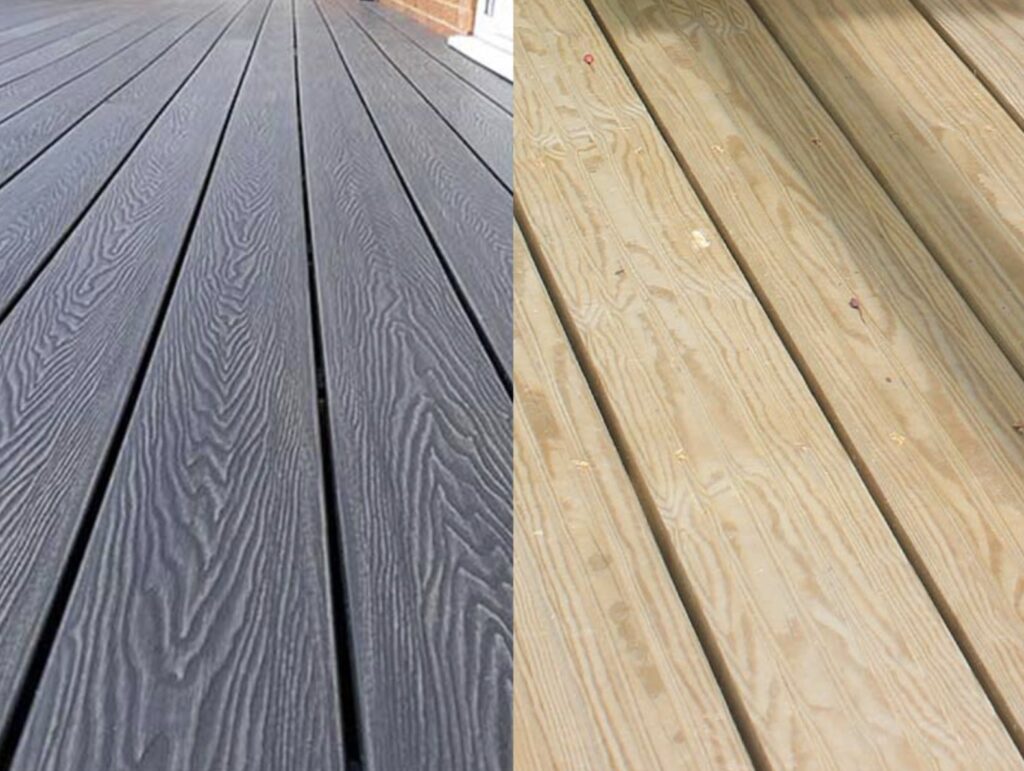
VII. Purple Heart Decking
Increasingly favored in New Zealand for its distinctive aesthetics, Purple Heart Decking is an exotic hardwood renowned for its vivid, deep violet hue. This luxurious option infuses outdoor areas with an extraordinary and sophisticated charm, alongside impressive natural durability and a resistance to decay, insects, and environmental wear.
Advantages of Purple Heart Decking:
- Striking Visual Appeal: The unique deep purple shade of this decking is a showstopper, offering a stunning and rare beauty to your outdoor space.
- Durability and Resilience: Known for its robust density, Purple Heart withstands decay, insects, and rot with ease, ensuring its longevity as a decking material.
- Low Maintenance Needs: Beyond the usual cleaning, Purple Heart decking does not demand much, retaining its beauty with minimal upkeep.
- Enhanced Property Value: Opting for this premium decking can elevate your property’s market worth, enriching its visual appeal and potential resale value.
Disadvantages of Purple Heart Decking:
- Premium Pricing: Reflecting its exotic status, Purple Heart comes with a higher price tag compared to other decking materials.
- Workability Challenges: The wood’s density may pose challenges during the installation process, potentially affecting labor time and costs.
- Specialized Tools Requirement: The hardness of the wood often necessitates the use of specialized tools for cutting and fitting.
- Import Regulations Compliance: Being an exotic species, Purple Heart decking is subject to specific import and environmental regulations that need careful consideration.
When opting for Purple Heart decking, professional consultation and installation are advisable to ensure optimal results. Consistent cleaning paired with periodic oiling can maintain its striking color and contribute to its longevity, making it an investment-worthy choice for an extraordinary outdoor setting.
III. Composite Decking
Composite decking is increasingly sought after by those who prefer timber’s aesthetic without the associated upkeep. This material is crafted from a blend of wood fibers and plastics, yielding a robust decking alternative that requires minimal maintenance.
Advantages of Composite Decking:
- Ease of Upkeep: With composite decking, the necessity for regular maintenance is significantly reduced, needing only periodic cleaning to maintain its appearance.
- Resistance to the Elements: This type of decking stands up remarkably well against decay, insect damage, and moisture, attributing to its durability and longevity.
- Variety of Choices: An extensive selection of colors and finishes ensures that composite decking can complement a multitude of home styles.
- Sustainable Option: Often made from recycled components, composite decking is a greener choice for the environmentally conscious homeowner.
Disadvantages of Composite Decking:
- Initial Cost Considerations: Generally, composite decking comes at a higher initial cost than both treated pine and most hardwoods, potentially stretching your budget.
- Potential for Stains and Fading: Exposure to the elements might lead to staining or the gradual fading of its color over time.
- Less Natural Appeal: Despite advances in manufacturing, some feel composite decking lacks the inherent warmth and unique characteristics of natural timber.
In New Zealand, brands like Trex, Modwood, and Futurewood are among the leading choices for composite decking, each offering a suite of products to suit various preferences and design requirements.
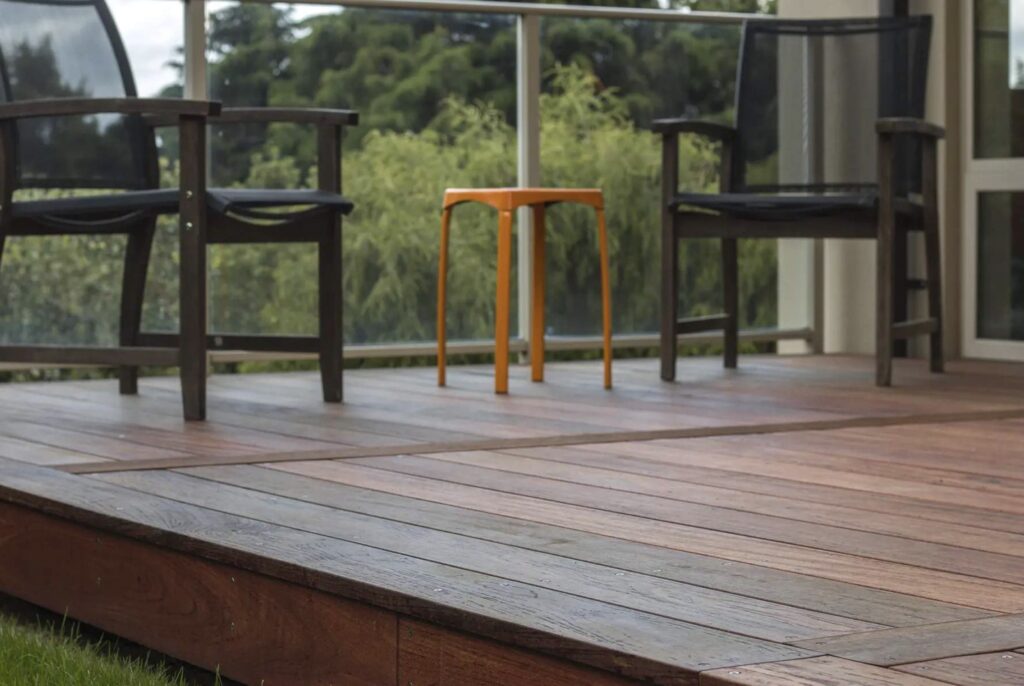
IV. PVC Decking
PVC decking represents an innovative addition to the New Zealand decking market, delivering a host of advantages. Constructed entirely from plastic, it is impervious to moisture, decay, and insect damage. This type of decking is offered in various hues and textures, enabling homeowners to find the perfect match for their home’s exterior.
Advantages of PVC Decking:
- Minimal Maintenance: The upkeep of PVC decking is relatively effortless, typically requiring only routine cleaning to maintain its appearance.
- Exceptional Durability: PVC decking stands up exceptionally well against moisture, insects, and decay, ensuring an enduring deck that withstands the elements.
- Diverse Selection: With an array of available colors and textures, PVC decking provides flexibility in design to harmonize with your home’s exterior.
- Eco-Conscious Choice: As PVC decking is often made using recycled plastic, it is a more sustainable option for the environment.
Disadvantages of PVC Decking:
- Higher Price Point: PVC decking generally comes at a higher price compared to traditional timber, which may not be ideal for those with a limited budget.
- Potential for Staining or Fading: Over time and with exposure to the outdoors, PVC decking might experience some degree of staining or color fading.
- Synthetic Aesthetic: Despite its ability to imitate the look of wood, some may find that PVC decking lacks the genuine warmth and unique qualities of real timber.
Renowned brands of PVC decking in New Zealand, such as TimberTech, Azek, and Clubhouse, offer a variety of premium products tailored to meet a range of design preferences and functional needs.
V. Concrete Decking
Concrete decking stands out as a robust and low-upkeep decking choice. It is crafted on-site, allowing for full customization to align with specific design aspirations. This style of decking is increasingly favored in contemporary architectural designs and in homes reflecting a minimalistic approach.
Advantages of Concrete Decking:
- High Durability: Concrete decking boasts exceptional longevity, enduring for many years without the need for replacement.
- Low Maintenance: The care for concrete decking is straightforward, typically necessitating just routine cleaning to sustain its appearance.
- Customizable Design: Since concrete can be shaped and poured to any specification, it offers great flexibility in design for your outdoor area.
Disadvantages of Concrete Decking:
- Higher Installation Costs: The initial setup of concrete decking might incur a higher cost due to the specialized equipment and skilled labor involved.
- Less Warmth than Timber: Unlike timber decking, concrete may lack the organic warmth and distinct character, potentially making it a less inviting choice for homes with traditional aesthetics.
- Design Limitations: Although it can be tailored to fit various shapes and sizes, concrete decking might offer fewer design variations in comparison to other materials.
To maintain the pristine condition of your concrete decking, regular cleaning coupled with periodic sealing is recommended. This not only prevents stains but also provides protection from general wear and tear, preserving the deck’s integrity and appearance.
VI. Frequently Asked Questions about Decking Materials
Which decking material offers the best value for money?
Treated pine is recognized as the most budget-friendly decking material in New Zealand, providing an economical option without sacrificing quality.
What type of decking demands the least upkeep?
Composite and PVC decking are the frontrunners for low-maintenance options, thanks to their resistance to decay, insects, and moisture.
Is it possible to stain or paint hardwood decking?
Certainly, hardwood decking can be stained or painted for aesthetic enhancement or protection. Ensure that the products used are formulated for hardwood application.
How frequently should hardwood decking be oiled?
Annually oiling your hardwood decking is recommended, although this might vary with the level of sun exposure and foot traffic the deck endures.
Are exotic hardwood decks, like Purple Heart, regulated upon import?
Importing exotic hardwoods can be subject to specific regulations to address sustainability and environmental impact. Always verify with suppliers that your decking is responsibly sourced and compliant with all relevant regulations.
VII. Conclusion
Selecting the appropriate decking material is crucial and requires thoughtful consideration of your budget, design vision, and willingness to maintain the structure over time. With various options available, such as timber, composite, PVC, and concrete, and with hardwood choices like Kwila and Garapa being top picks, the decision ultimately rests on what best aligns with your unique requirements and preferences. Deliberate on the choices at hand and seek professional advice to ensure that your final decision yields a deck that enhances your home’s value and your outdoor living experience.
